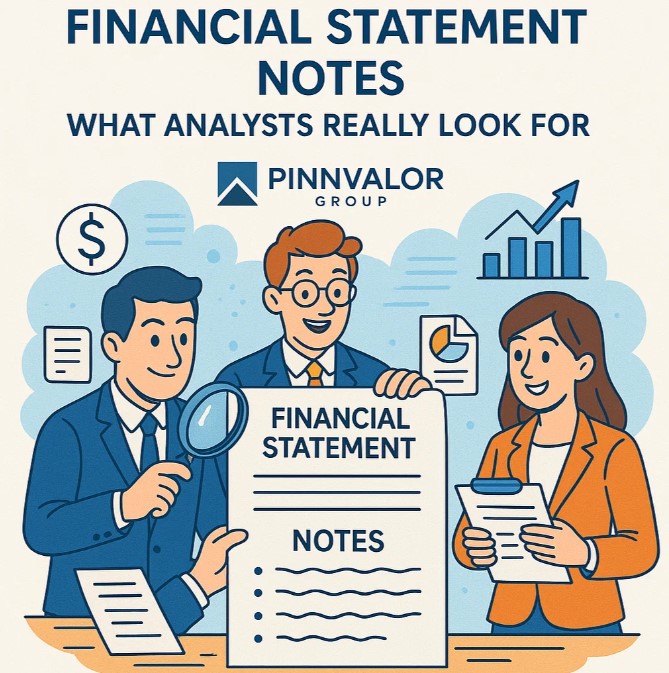
Decoding Financial Statement Notes: What Analysts Really Look For
When it comes to analyzing a company’s financial health, most eyes go straight to the primary financial statements—the balance sheet, income statement, and cash flow statement. However, seasoned financial analysts know that the real insights often lie hidden in the footnotes. These financial statement notes are not just legal formalities; they are rich sources of information that provide critical context, clarify accounting assumptions, and reveal risks not immediately apparent in the headline figures.
What secrets do financial statement footnotes reveal that the main reports often hide?
Numbers tell a story, but disclosures reveal the plot twists. Understanding footnotes is what separates good analysts from great ones.
In this blog, we’ll explore why financial statement notes matter, what analysts specifically look for, and how these disclosures influence investment and valuation decisions.
Why Financial Statement Notes Matter
Financial statement notes (also known as footnotes or disclosures) are an integral part of a company’s annual or quarterly financial reports. They provide:
- Clarification of accounting policies and estimates
- Breakdown of line items on financial statements
- Disclosure of contingent liabilities and off-balance-sheet obligations
- Information on related party transactions, litigation, and risks
Without these disclosures, analysts would be left interpreting numbers without understanding the story behind them.
Key Areas Analysts Focus On in Financial Statement Notes
1. Accounting Policies and Estimates
The first section in most notes describes the accounting policies used by the company. Analysts assess:
- Revenue recognition methods: Is revenue recognized at point of sale or over time?
- Inventory valuation: FIFO, LIFO, or weighted average? This can impact cost of goods sold and profits.
- Depreciation methods: Straight-line vs. accelerated methods can skew comparisons.
- Estimates and assumptions: Provisions for doubtful debts, warranty liabilities, and impairment are based on judgment. Analysts evaluate how aggressive or conservative these estimates are.
Why it matters: Changes in policies or aggressive assumptions may inflate earnings or hide future risks.
2. Segment Information
Companies with diversified operations often report segmented results in the notes. This includes:
- Revenue and profit by geographic region or product line
- Capital expenditures and asset allocation by segment
Analysts use this to:
- Identify high-performing vs. underperforming units
- Evaluate geographic or product-specific risks
- Perform sum-of-the-parts (SOTP) valuations
3. Contingent Liabilities and Legal Proceedings
Contingent liabilities are potential obligations that depend on the outcome of uncertain future events—such as lawsuits, tax disputes, or guarantees.
Why analysts care:
- These are red flags. A major lawsuit or regulatory issue can materially affect a company’s financials, even if it’s not yet reflected in the main statements.
4. Debt Details and Covenants
While the balance sheet shows the total debt, the notes break it down by:
- Type (secured vs. unsecured)
- Maturity schedule
- Interest rates and repayment terms
- Loan covenants and compliance status
Analysts assess:
- Liquidity risk and refinancing needs
- Financial flexibility
- Covenant headroom (i.e., how close a company is to breaching loan terms)
5. Pension and Post-Retirement Benefits
Defined benefit pension plans and other long-term employee obligations are often underfunded.
Analysts look at:
- Funded status of the plan
- Assumptions around discount rates and expected returns
- Future funding obligations
Why it matters: Underfunded pensions can lead to cash flow strain and hidden liabilities.
6. Related Party Transactions
Transactions with directors, subsidiaries, or other connected entities can sometimes be structured in ways that benefit insiders at the expense of shareholders.
Analysts watch for:
- Unusual terms or pricing
- Repeated or large-scale transactions
- Lack of transparency

7. Subsequent Events
Events that occur after the balance sheet date but before the financials are issued can have significant implications.
Examples include:
- Mergers/acquisitions
- Major asset sales
- Debt restructurings
- Natural disasters
These are key for: Ensuring the analyst's valuation model reflects the latest known developments.
8. Impairments and Write-downs
The notes often explain impairments in assets such as goodwill, PP&E, or intangibles.
What analysts evaluate:
- The reasons behind the impairment
- Whether future impairments might be likely
- The impact on recurring vs. non-recurring earnings
How This Impacts Valuation and Investment Decisions
- Earnings Quality Assessment: Footnotes help analysts distinguish between recurring and non-recurring items, revealing the true quality of earnings.
- Risk Analysis: Disclosures related to legal, regulatory, or operational risks allow for a more comprehensive risk assessment.
- Forecasting and Modeling: Accurate forecasting depends on understanding the underlying drivers of performance, which are often explained in the footnotes.
- Comparability Across Companies: Standard financial line items may not tell the whole story, especially when companies use different assumptions or accounting methods. Footnotes help normalize these for better peer comparisons.
Final Thoughts
For the serious financial analyst, financial statement notes are not optional reading—they are essential. They help uncover the “why” behind the numbers, provide early warning signs of trouble, and surface valuable qualitative information that can enhance quantitative models.
In an age where automated financial summaries and AI-powered analytics are growing, the ability to interpret and critically evaluate disclosures in financial statement notes remains a differentiating skill.
Pro Tip for Analysts: Always read the footnotes before finalizing any valuation model or investment thesis. What’s not on the front page may be exactly what moves the market.
